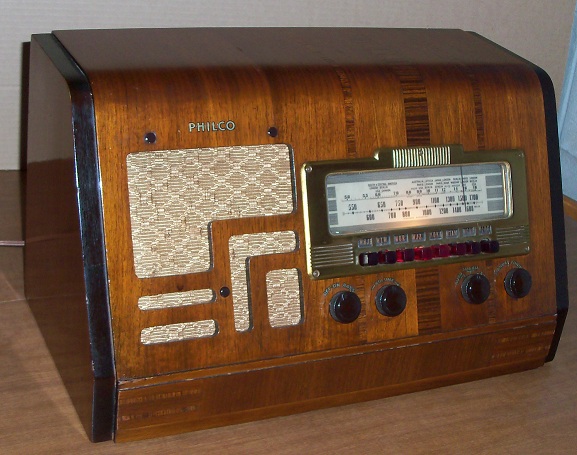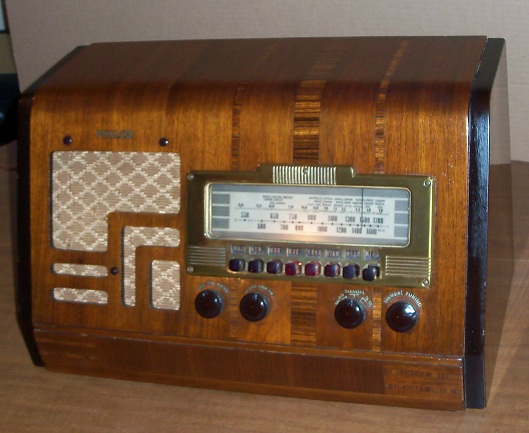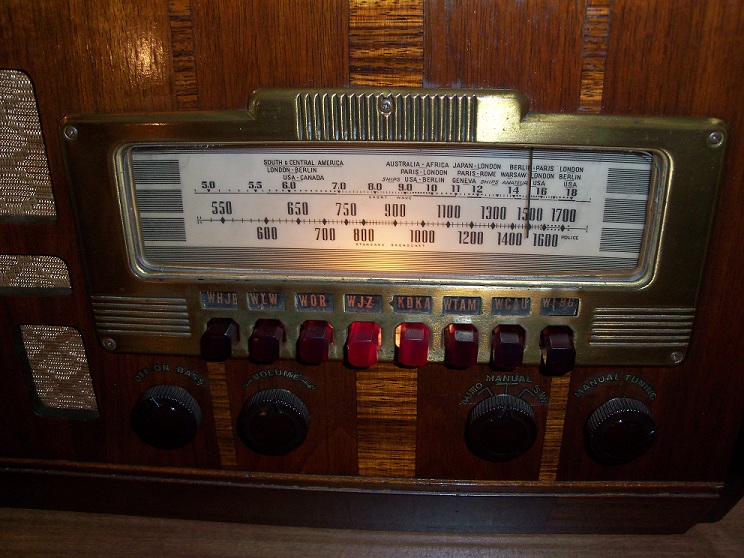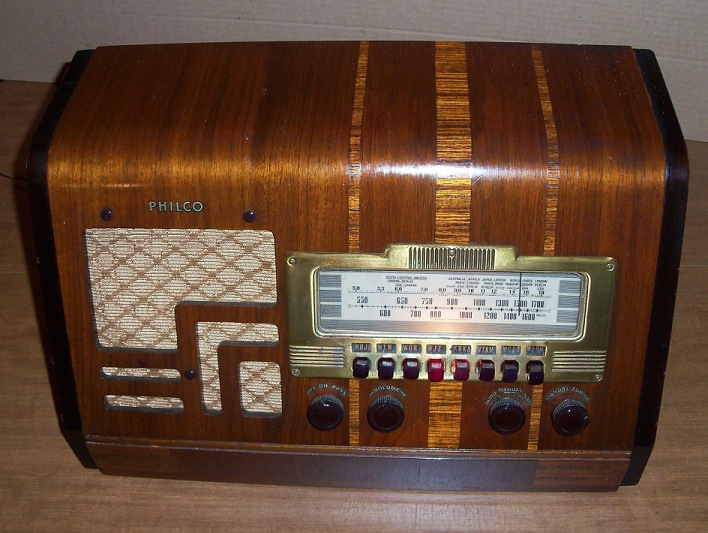Posts: 1,531
Threads: 242
Joined: Sep 2012
City: West Bend, Wisconsin
Greg V.
West Bend, WI
Member WARCI.org
Posts: 7,300
Threads: 268
Joined: Dec 2009
City: Roslyn Pa
Nice Job! Look lke an eastern set, most of those stations I can get over here. WCAU is WPHT now as of 10 or so years ago. I don't understand why stations change call signs after many many years. Kinda like us hams the FCC has allowed us the to have call signs which don't necessarily have to be in the call district we are in. It's a bit of annoyance you think the guy is in Calf. but he's next door.
Terry
Posts: 52
Threads: 1
Joined: Mar 2013
City: Minneapolis, MN
Any stray capacitance between the 75 grid cap and the plate of the output tube ( 41, 42, etc.) can cause hi freq audio oscillation. Dress the grid lead away and/or try some shielding.
Posts: 761
Threads: 56
Joined: Jul 2013
City: Kentucky
Beautiful radio. Great job!
The artist formerly known as Puhpow! 8)
Posts: 120
Threads: 10
Joined: Jul 2011
City: Glendale, CA
I've got a 39-30 as well. I have seen some 39-30's with only 1 tube shield, on the 75 tube. For whatever reason, my radio has provisions for two tube shields, on the 75 and the 37. But, when I got it, it only came with only 1 actual tube shield installed, on the 75. Could that be part of your problem?
Tom
Posts: 2,353
Threads: 92
Joined: May 2010
City: Clayton, NC
Bill/Tom: great advice. Funny thing about 75 tubes, the mutual conductance of the triode is only 750 uMhos, and it doesn't take long for it to degrade to the 500 range. In sets where the 75 is the only AF amp before the output tube this can be an issue.
Also: 42 tubes can be noisy after they warm up. Same goes for 6F6 tubes.
Posts: 2,353
Threads: 92
Joined: May 2010
City: Clayton, NC
Posts: 1,531
Threads: 242
Joined: Sep 2012
City: West Bend, Wisconsin
Mine only has one tube shield too over the 75 tube.
Greg V.
West Bend, WI
Member WARCI.org
Posts: 77
Threads: 24
Joined: Nov 2010
City: Oradell, NJ
Quote:It took three #75 tubes until I found a good one that didn't cause a muffled hissing after the set played for about 5 or 10 minutes
That might have been a supersonic parasitic oscillation. A "grid stopper" resistor, around 68K, placed in series with the grid wire right at the top cap of this tube (its grid), should tame those unruly tubes you have. This resistor, in combination with the tube's stray capacitance, acts like a low pass filter to disable the oscillation.
(This post was last modified: 09-20-2013, 04:33 PM by wa2ise.)
Posts: 61
Threads: 2
Joined: Aug 2013
City: Renton, Wa
Real nice looking set--great restoration !
Posts: 1,531
Threads: 242
Joined: Sep 2012
City: West Bend, Wisconsin
Thanks, everyone. The set is working fine now. I think it had a lot to do with shielding around that 75 tube. No more muffled hissing. 
Greg V.
West Bend, WI
Member WARCI.org
Posts: 1,531
Threads: 242
Joined: Sep 2012
City: West Bend, Wisconsin
I really like the rear lighted dial on these 1939's. And, using the "Rebuilding Philco Pilot Lamps" tip found in the tech section ( http://philcoradio.com/tech/lamps.htm ) it no longer flickers on and off! 
Greg V.
West Bend, WI
Member WARCI.org
Posts: 481
Threads: 18
Joined: Jan 2013
City: Mesa, AZ
Still love those wine flavored buttons! 
Posts: 4,870
Threads: 54
Joined: Sep 2008
City: Sandwick, BC, CA
Another thing to watch for on a 75 tube, or any other glass tube with a grid cap, is the solder joint on the grid cap giving out. Also the clip on the end of the grid lead can have problems, the solder joint going bad or the wire breaking internally.
Regards
Arran
Posts: 825
Threads: 113
Joined: Aug 2012
City: The Villages
State, Province, Country: Florida
Wow. Really great restoration!  
Eric
The Villages, FL
Member: Philco Phorum, ARF, ARCI & Radiomuseum.org
Users browsing this thread: 1 Guest(s)
|
|
Recent Posts
|
|
The list of my radio & TV collection!
|
| Yes, Michael. But strangely enough, I managed to keep the original veneer. I must admit that I don't really like it, so ...RadioSvit — 02:21 PM |
|
The list of my radio & TV collection!
|
| Good radio.
I bet there was a lot of veneer fixing.morzh — 02:16 PM |
|
Philco 46-480 Electronic Restoration
|
| >> it is because I am retired and a little demented.
You have just the right amount of it. No perfectly sane p...morzh — 02:14 PM |
|
The list of my radio & TV collection!
|
| Old Zenith 5S-29 tube radio. First turn-on after repair and reception quality testing. Demonstration of the operation of...RadioSvit — 01:27 PM |
|
Philco 42-345 Restoration/Repair
|
| Welcome to the Phorum, osanders0311! Regardless how far you intend to restore this set, first priority should be replac...GarySP — 11:51 AM |
|
Philco 46-480 Electronic Restoration
|
| Joseph, it is because I am retired and a little demented. My problem is that I wanted to own a collection that spans th...MrFixr55 — 11:29 AM |
|
Philco 46-480 Electronic Restoration
|
| Wow, here I am with only two restored radios. I’ve got to boost those numbers! If you can’t run with the big dogs, you m...jrblasde — 10:04 AM |
|
Philco 46-480 Electronic Restoration
|
| Hello MrFixr55,
That will for sure keep you out of trouble!
Last Sunday was spent mostly doing yard work anyway the we...radiorich — 09:50 AM |
|
Philco 46-480 Electronic Restoration
|
| Throw in all the Audio equipment that has to be kept in a bedroom (my office)L. 8 portable self contained PA speakers, ...MrFixr55 — 07:40 AM |
|
Philco 42-345 Restoration/Repair
|
| Looking at the pic supplied by Rod B, you can duplicate the missing loop antenna. 10 gauge copper wire can be used to m...MrFixr55 — 01:20 AM |
|
Who's Online
|
There are currently 1099 online users. [Complete List]
» 2 Member(s) | 1097 Guest(s)
|
|
|

|
 
|







![[-] [-]](https://philcoradio.com/phorum/images/bootbb/collapse.png)


